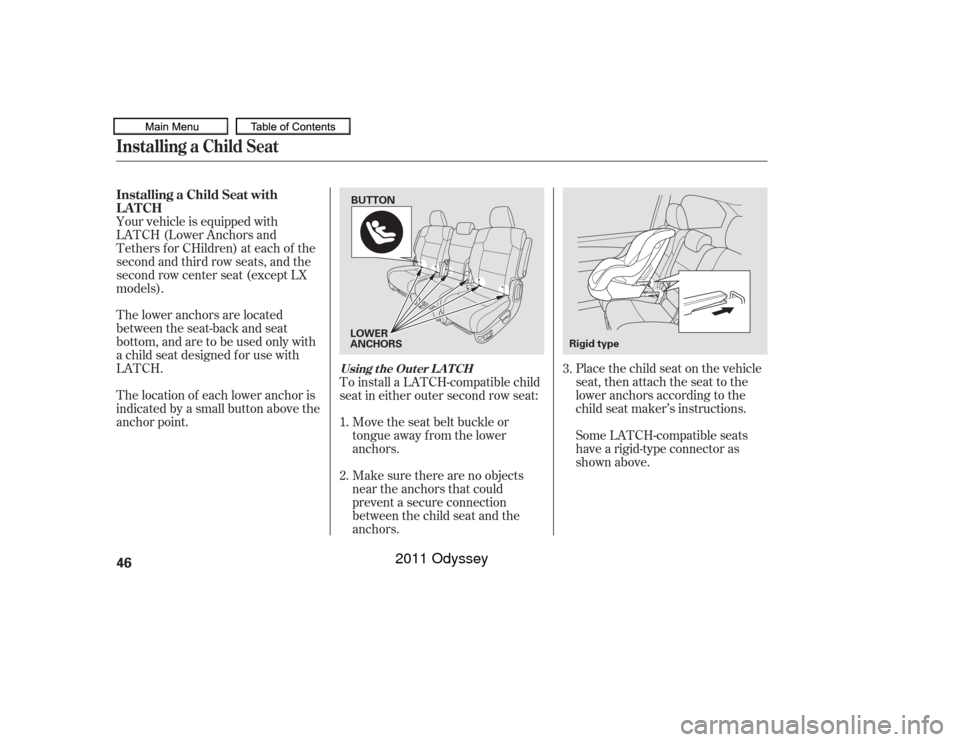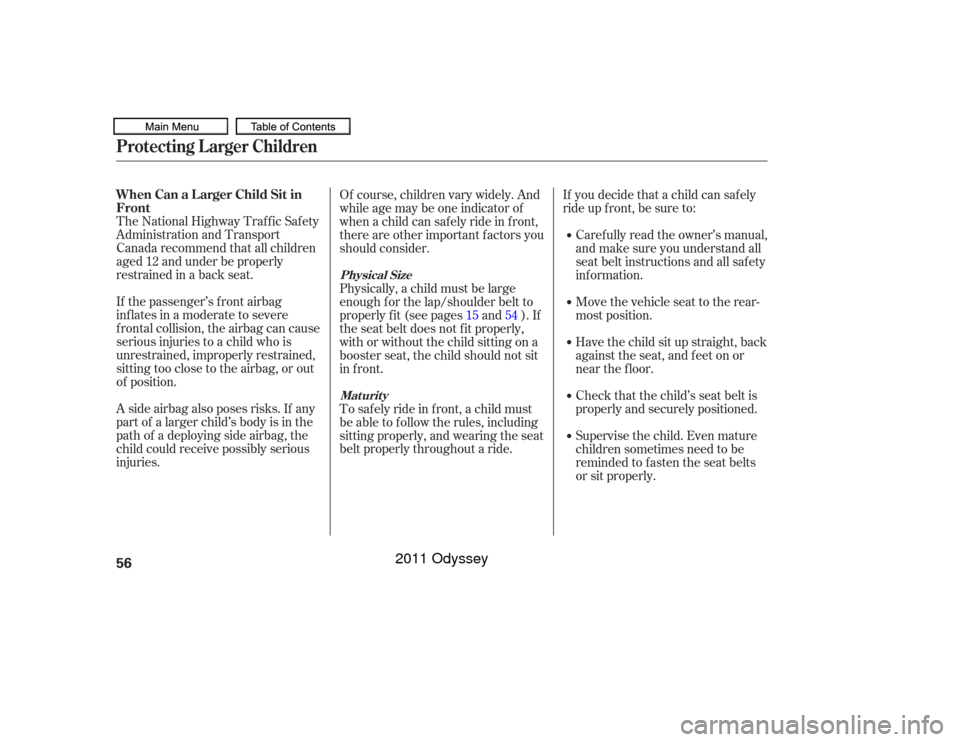Page 44 of 722

An inf ant must be properly
restrained in a rear-f acing, reclining
child seat until the child reaches the
seat maker’s weight or height limit
f or the seat, and the child is at least
one year old.If the passenger’s front airbag
inflates, it can hit the back of the
child seat with enough f orce to kill or
seriously injure an inf ant.
When properly installed in the
second row, a rear-f acing child seat
maypreventthedriverorafront
passenger f rom moving their seat as
f ar back as recommended, or f rom
locking their seat-back in the desired
position.
If placed
f acing f orward, an inf ant could be
very seriously injured during a
f rontal collision. Two types of seats may be used: a
seat designed exclusively f or inf ants,
or a convertible seat used in the rear-
f acing, reclining mode. Only a rear-f acing child seat provides
proper support f or a baby’s head,
neck, and back. A rear-f acing child seat can be placed
in any seating position in the second
or third row, but not in the f ront.
It could also interf ere with proper
operation of the passenger’s
advanced front airbag system.
CONT INUED
Protecting Inf antsChild Seat T ype Do not put a rear-f acing child seat in
a f orward-f acing position. Rear-f acing Child Seat Placement
Never put a rear-f acing child seat inthe front seat.
Protecting Inf ants and Small Children
Driver and Passenger Saf ety
41
Placing a rear-facing child seat
in the front seat can result in
serious injury or death during a
crash.
Always place a rear-facing child
seat in the back seat, not the
front.
10/07/17 09:39:51 31TK8600_046
2011 Odyssey
Page 49 of 722

Place the child seat on the vehicle
seat, then attach the seat to the
lower anchors according to the
child seat maker’s instructions.
Some LATCH-compatible seats
have a rigid-type connector as
shown above.
The lower anchors are located
between the seat-back and seat
bottom, and are to be used only with
a child seat designed f or use with
LATCH.
The location of each lower anchor is
indicated by a small button above the
anchor point. Your vehicle is equipped with
LATCH (Lower Anchors and
Tethers f or CHildren) at each of the
second and third row seats, and the
second row center seat (except LX
models).
Make sure there are no objects
near the anchors that could
prevent a secure connection
between the child seat and the
anchors. Move the seat belt buckle or
tongue away f rom the lower
anchors.
To install a LATCH-compatible child
seat in either outer second row seat:
1.
2. 3.
Installing a Child Seat with
LATCH
Installing a Child Seat
Using t he Out er L A T CH
46
LOWER
ANCHORS BUTTON
Rigid type
10/07/17 09:40:26 31TK8600_051
2011 Odyssey
Page 51 of 722
Lif t the head restraint (see page), then route the tether strap
through the legs of the head
restraint and over the seat-back,
making sure the strap is not
twisted.
Attach the attaching clip to the
anchor fitting, then tighten the
strap as instructed by the child
seat maker.
Unlatch the detachable seat belt
anchor latch and retract the seat
belt all the way into the ceiling.
Place the latch plate and anchor
latch in their holding slots (see
page ).
Remove the covers on each lower
end of the seat-back by pulling on
the handles.
To install a LATCH-compatible child
seat in the second row center seat
(except LX models), use the center
lower anchors as shown above. Follow step 1 through 4 as
described previously to secure the
child seat.
1.
2.
3.
4.
5.
187
179
Installing a Child SeatUsing t he Cent er L A T CH48
LOWER ANCHORS
BUTTON TETHER STRAP
ATTACHING CLIP TETHER ANCHOR FITTING
HANDLE
COVER
10/07/17 09:40:43 31TK8600_053
2011 Odyssey
Page 59 of 722

The National Highway Traffic Safety
Administration and Transport
Canada recommend that all children
aged 12 and under be properly
restrained in a back seat.
If the passenger’s front airbag
inf lates in a moderate to severe
f rontal collision, the airbag can cause
serious injuries to a child who is
unrestrained, improperly restrained,
sitting too close to the airbag, or out
of position.
A side airbag also poses risks. If any
part of a larger child’s body is in the
path of a deploying side airbag, the
child could receive possibly serious
injuries.Of course, children vary widely. And
while age may be one indicator of
when a child can saf ely ride in f ront,
there are other important f actors you
should consider.
Physically, a child must be large
enough f or the lap/shoulder belt to
properly f it (see pages and ). If
the seat belt does not f it properly,
with or without the child sitting on a
booster seat, the child should not sit
in f ront.
To saf ely ride in f ront, a child must
be able to f ollow the rules, including
sitting properly, and wearing the seat
belt properly throughout a ride.
If you decide that a child can saf ely
ride up f ront, be sure to:
Caref ully read the owner’s manual,
and make sure you understand all
seat belt instructions and all saf ety
inf ormation.
Move the vehicle seat to the rear-
most position.
Have the child sit up straight, back
against the seat, and feet on or
near the f loor.
Check that the child’s seat belt is
properly and securely positioned.
Supervise the child. Even mature
children sometimes need to be
reminded to f asten the seat belts
or sit properly.
15 54Protecting L arger ChildrenWhen Can a L arger Child Sit in
Front
Physical Size
Maturity
56
10/07/17 09:41:49 31TK8600_061
2011 Odyssey
Page 62 of 722
These labels are in the locations
shown. They warn you of potential
hazards that could cause serious
injury or death. Read these labels
caref ully.
If a label comes of f or becomes hard
to read (except for the U.S.
dashboard label which may be
removed by the owner), contact your
dealer f or a replacement.
CONT INUED
Canadian modelsU.S. models only
U.S. models
Saf ety L abels
Driver and Passenger Saf ety
59
DASHBOARD
SUN VISORS
10/07/17 09:42:14 31TK8600_064
2011 Odyssey
Page 66 of 722

�Î
�Î �Î
�Î
�Î
The U.S. instrument panel is shown. Dif f erences f or the Canadian models are noted in the text.
: If equipped
Instrument Panel
Instruments and Controls
LX, EX, EX-L models
63
LOW TIRE PRESSURE INDICATOR
LIGHTS ON INDICATORDAYTIME RUNNING
LIGHTS (DRL)
INDICATOR
SEAT BELT
REMINDER
INDICATOR
LOW FUEL
INDICATOR
STARTER SYSTEM INDICATOR
CRUISE MAIN INDICATOR
CRUISE CONTROL INDICATOR
IMMOBILIZER SYSTEM
INDICATOR VSA OFF INDICATOR VEHICLE STABILITY ASSIST (VSA)
SYSTEM INDICATOR MALFUNCTION INDICATOR LAMP FUEL ECONOMY INDICATOR
MAINTENANCE MINDER INDICATOR
SIDE AIRBAG OFF INDICATOR
HIGH BEAM INDICATOR
PARKING BRAKE AND BRAKE
SYSTEM INDICATOR
TIRE PRESSURE
MONITORING
SYSTEM (TPMS)
INDICATOR
CHARGING SYSTEM INDICATOR
LOW OIL PRESSURE INDICATOR
DOOR and TAILGATE OPEN INDICATOR SECURITY SYSTEM INDICATOR
PARKING SENSOR INDICATORS
POWER SLIDING DOOR INDICATOR POWER TAILGATE INDICATOR (P.71)
(P.75)
(P.69)
(P.69)
(P.69)
(P.72) (P.66)
(P.66)
(P.74) (P.75)
(P.487)
(P.75)
(P.66)
(P.76) (P.73)
(P.76)
(P.70)
(P. 75)
(P.75)
(P.73)
(P. 73)
(P.65) (P. 74)
(P.68)
(P.67)
SUPPLEMENTAL RESTRAINT
SYSTEM (SRS) INDICATOR
(P.
67)
ANTI-LOCK BRAKE SYSTEM (ABS) INDICATOR (P.68)
10/07/19 15:50:28 31TK8600_068
2011 Odyssey
Page 67 of 722

�Î
�Î
The U.S. instrument panel is shown. Dif f erences f or the Canadian models are noted in the text.: If equippedInstrument PanelT ouring models64
FUEL ECONOMY INDICATOR SYSTEM MESSAGE INDICATOR
ANTI-LOCK BRAKE SYSTEM INDICATOR SIDE AIRBAG OFF INDICATOR
MALFUNCTION INDICATOR LAMP
VEHICLE STABILITY ASSIST (VSA)
SYSTEM INDICATOR
VSA OFF INDICATOR
IMMOBILIZER SYSTEM
INDICATOR
CHARGING SYSTEM
INDICATOR
LOW OIL PRESSURE INDICATOR
PARKING BRAKE AND BRAKE SYSTEM INDICATORSEAT BELT REMINDER INDICATOR
SUPPLEMENTAL RESTRAINT
SYSTEM INDICATOR
LOW FUEL
INDICATOR
HIGH BEAM INDICATOR SECURITY SYSTEM INDICATOR
CRUISE MAIN INDICATOR
CRUISE CONTROL INDICATORLIGHTS ON INDICATOR
FOG LIGHT
INDICATOR
BLIND SPOT INFORMATION SYSTEM INDICATOR (P.73)
(P.75)
(P.66)
(P.69) (P.69)
(P.69)
(P.66) (P.66)(P.70)
(P.68) (P.
76)
(P. 76)
(P.75) (P.75)
(P.73)
(P. 73)
(P. 74)
(P. 65)
(P. 67)
(P. 68)
(P.67)
LOW TIRE PRESSURE/TPMS INDICATOR (P.71)
DOOR and TAILGATE OPEN INDICATOR (P.75)
10/07/19 15:50:37 31TK8600_069
2011 Odyssey
Page 68 of 722

The instrument panel has many
indicators to give you important
inf ormation about your vehicle. This indicator comes on when youturn the ignition switch to the ON
(II) position. It reminds you and your
passengers to f asten your seat belts.
A beeper also sounds if you have not
f astened your seat belt.
If you turn the ignition switch to the
ON (II) position bef ore f astening
your seat belts, the beeper sounds,
and the indicator f lashes. If you do
not fasten your seat belts before the
beeper stops, the indicator stops
f lashing but remains on. If your f ront passenger does not
f asten their seat belt, the indicator
comes on about 6 seconds af ter the
ignition switch is turned to the ON
(II) position.
If either of you do not f asten your
seat belt while driving, the beeper
will sound and the indicator will f lash
again at regular intervals. For more
inf ormation, see page .
You will also see a ‘‘FASTEN SEAT
BELT’’ or ‘‘FASTEN PASSENGER
SEAT BELT’’ message on the multi-
inf ormation display (see page ).
20
90
On Touring models
Seat Belt Reminder
Indicator
Instrument Panel Indicators
Instruments and Controls
65
10/07/17 09:43:00 31TK8600_070
2011 Odyssey